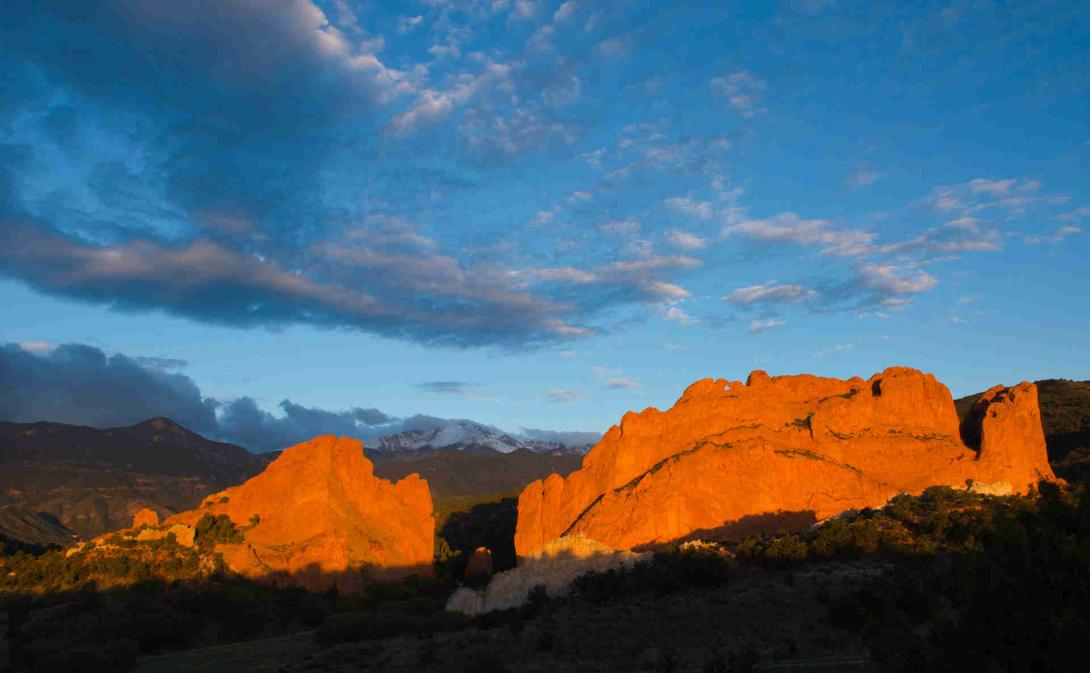Lyons Sandstone
Full Article
Named for the Boulder County town whose historic quarries made it famous, the Lyons Sandstone formation is a Permian age rock layer in the foothills of the Front Range from the Wyoming border to south of Colorado Springs. It is the primary formation in the scenic red rock outcrops at Garden of the Gods Park near Colorado Springs.
Ancient Uses
People have made use of the well-cemented sandstones of the Lyons formation for thousands of years, beginning at least 6,500 years ago in the Archaic period. Because the sandstone usually occurs in flat layers of varying thickness, such as flagstone, it was a popular raw material among American Indians for seed-milling slabs called metates and the handheld counterparts called manos. These artifacts have been found throughout the Front Range region from the open plains to near the Continental Divide, many miles from the outcrops where the material was gathered. Although the milling of wild plant seeds into flour was the primary function of these tools, corn grinding was added in the Formative period after 200 CE. In addition, small pieces of sandstone were used as a kind of natural sandpaper for abrading and smoothing work. The sandstone was quarried from many locations between Manitou Springs and Fort Collins.
Historic Quarrying
In more recent times, the quarries around the town of Lyons constituted a major source of Lyons sandstone. Edward S. Lyon, the town’s founder, began commercial quarrying in 1880 in competition with quarries west of Fort Collins that were backed by the Union Pacific Railroad. A railroad line running into Lyons had to wait until Hugh Murphy, a paving contractor from Omaha, Nebraska, bought part of Lyon’s holdings in 1884.
Lyons sandstone served as a building material, but its primary use was for paving stones and sidewalks. Quarrymen, mostly immigrants from Scandinavia, cut sidewalk slabs directly from the bedding planes using shims and wedges (known as “blocks and feathers”). Other quarries in nearby Noland and Beech Hill competed with Murphy for markets, but demand declined as asphalt and concrete became more popular pavement materials in the early twentieth century. In 1916 Murphy sold the business to his superintendent, John Brodie. Brodie’s quarry remained viable by crushing the stone for use as a road base. The Brodie quarry contributed some stone to the construction of the University of Colorado’s Boulder campus, which had adopted a new architectural style in the 1920s.
Modern Sandstone Industry
The ranch-style houses and suburban culture that developed in California and other areas after World War II gave consumers a taste for patios and other decorative landscape features. Quarries in Arizona made profits from the new demand for stone. Not until 1946, however, did Colorado quarries become aware of the opportunity. That year a Californian named Dewey Summers came to Boulder County with his wife, May Vickery, to restore his health. May’s brothers lived in nearby Jamestown and were working as quarrymen. When Summers saw the quality of the sandstone that her brothers were quarrying, he went into business.
Soon the local industry could not keep up with the demand. Other entrepreneurs such as Les Stennette and Irving Jacobson started quarrying to meet their own construction needs. The major bottleneck in production involved cutting the sandstone pieces to customers’ specifications. Although several stonecutting prototypes existed, Summers chose one invented by Chris Jenkins of Kansas City, Missouri, and enticed Jenkins to move his enterprise to Colorado, where his machine transformed the industry.
The use of Lyons sandstone has spread across the country from California to New York, and into Canada. In 1950 Chris Jenkins recognized Lyons sandstone in a New York City sidewalk. Buildings at the University of Texas at San Antonio; the US Geological Survey’s research center in Reno, Nevada; and the Hotel Chaco in Albuquerque, New Mexico, are among the many other places that feature this rock.
Today, several companies continue the tradition of Lyons sandstone quarrying along the Front Range. The material’s uses have spread beyond wall construction and pavers to such products as signage, outdoor furniture, landscaping accents, and artwork. The quality and beauty of this material have proven its appeal to Coloradans for thousands of years.


















